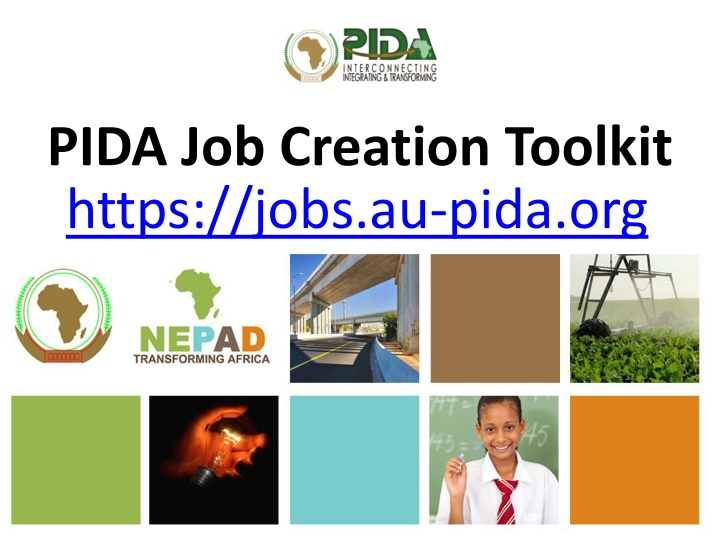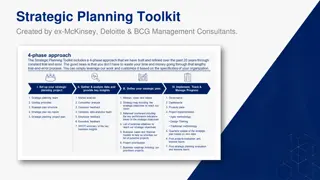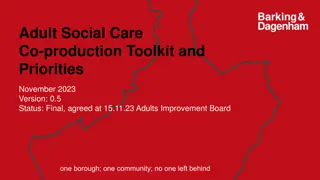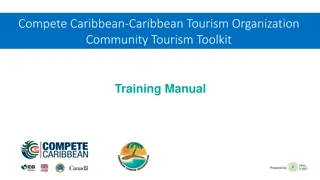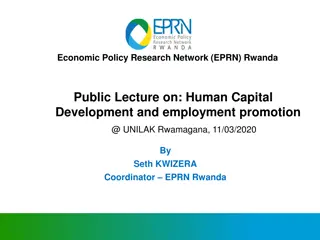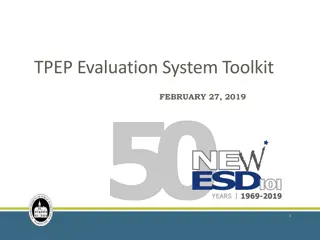PIDA Job Creation Toolkit - Maximizing African Job Opportunities
Aimed at maximizing employment opportunities in Africa, the PIDA Job Creation Toolkit helps estimate and enhance job creation across various sectors during infrastructure projects. It includes interventions to increase job quality and quantity, showcases case studies, and utilizes Input-Output tables for job estimation.
Download Presentation

Please find below an Image/Link to download the presentation.
The content on the website is provided AS IS for your information and personal use only. It may not be sold, licensed, or shared on other websites without obtaining consent from the author.If you encounter any issues during the download, it is possible that the publisher has removed the file from their server.
You are allowed to download the files provided on this website for personal or commercial use, subject to the condition that they are used lawfully. All files are the property of their respective owners.
The content on the website is provided AS IS for your information and personal use only. It may not be sold, licensed, or shared on other websites without obtaining consent from the author.
E N D
Presentation Transcript
PIDA Job Creation Toolkit https://jobs.au-pida.org
Overview Aims at maximizing African jobs during preparation, construction, and operation of infrastructure projects 1. Estimate Number and Types of Jobs: Helps project owners, technical partners, and government policy makers to estimate the full spectrum of jobs created from projects including: o Direct jobs : jobs during preparation and construction o Indirect jobs : jobs by suppliers to the project o Induced jobs : jobs by spending of direct and indirect workers o Secondary jobs : jobs as a result of improved infrastructure service from completed projects (economic spill-overs) disaggregate job estimates by sectors of the economy in which jobs are created
Overview 2. Job Maximization Interventions: explore the possibilities of increasing the number and quality of jobs develop job maximization scenarios to test how different project inputs and country sources change the level and country location of estimated jobs provide range of jobmaximizationpolicies, programs, processes, etc. 3. Case Studies: provide examples from both developing and developed countries that leverage existing project & policy interventions; Utilizes national Input-Output tables covering African countries generated from the Global Trade Analysis Project (GTAP) database consisting of regional input-output data, macroeconomic data, bilateral trade flows.
JOBS ESTIMATION USING INPUT-OUTPUT TABLES Output side (use side) End demand Sector Estimate infrastructure investment by input category (e.g., construction, equipment, etc.) Gross domestic product Direct, indirect and induced jobs in project preparation, construction, and operations & maintenance Input-Output table (each column of the input-output matrix reports the monetary value of an industry's inputs and each row represents the value of an industry's output). Goods/Sector Volume of Goods - = = + Investments Households Imports Inputs Exports Imports State Input side Inputs + Value added Jobs resulting from secondary effects = Estimate increase in electricity generation, trade volumes, etc. Gross production + Imports = Volume of goods I-O tables depict the interdependencies between economic sectors, and are used to estimate the impact of positive or negative economic shocks on an economy (investment in infrastructure is a positive shock) I-O Tables assumes that some inputs (investment in infrastructure) are used by sectors that produce output (intermediate output), which in turn is sold to another sector for consumption (final output); total output adds intermediate and final outputs By using labor productivities, one can calculate job creation from output
Financial Attractiveness Description & Example The risks of non-payment by companies or governments in a given country caused by conditions or events outside any developer's control e.g. Euler Hermes Country Risk ratings Country Risks Project implementation will be facilitated in case there is an enabling regulatory framework regarding operations, and it exists harmonization between the concerned countries e.g. there is a specific regulatory framework for operations in the sector Regulation Context Conditions Access to Financing The financial institutions must be willing and capable to finance the project (Local and International) The private sector' appetite can been measured through the track record of private sector investments made in similar projects in the sector and in the countries involved e.g. Private Participation in Infrastructure (PPI) project database Investment Activity The Governments involved have endorsed the project e.g. included in a sector master plan, multiannual budget, government project pipeline or it has been publicly announced by the Government. Political Support Good project management capacity is necessary for project success, especially when tackling the complexity of cross-border projects. Governance Project Conditions The documentation relative to the project s stage attains international standards. Projects beyond stage 2A should provide key financial ratios and a financial model e.g. Equator Principles Project Soundness The following risks must be clearly identified and allocated to the public and private sector e.g.: (i) Revenue certainty; (ii) Operational risks; (iii) CAPEX risks; (iv)Technology risks; (v) Environmental/Social risk; and (vi) Financial risks e.g. risks have been clearly identified and allocated with no unmanageable red flags raised Risk Management
Output Example: ESTIMATED JOBS BY ECONOMIC SECTOR Zambia Zimbabwe Secondary Jobs During Operations Phase 101 Total Jobs in Operations Phase 118 Secondary Jobs During Operations Phase 985 Total Jobs in Operations Phase 1,541 Induced Preparation Phase Jobs Induced Construction Phase Jobs Induced Preparation Phase Jobs Induced Construction Phase Jobs Induced O&M Jobs Induced O&M Jobs ECONOMIC SECTORS ECONOMIC SECTORS Agriculture & Food Products 3 3,249 519 Agriculture & Food Products Textiles, Apparel, Leather Wood & Paper Products Mining 2 71 16 0 21 4 37 42 Textiles, Apparel, Leather Wood & Paper Products Mining Cement, Mineral, Chemical, Petroleum & Other Products 0 1 0 26 26 0 7 2 64 69 1 7 2 106 112 0 55 13 1,755 1,834 0 0 1 8 0 1 3 49 4 52 Cement, Mineral, Chemical, Petroleum & Other Products Metal Products Manufacturing 0 22 3 12 21 Metal Products Manufacturing Electricity, Gas, and Water Generation & Distribution Construction Labour Trade Transport Communication Financial Services Business Services Other Services Public Administration 0 Total Average Annual Jobs 0 0 0 0 0 14 0 0 0 3 20 3,919 3 20 3,920 0 0 14 14 2 2 31 164 47 177 Electricity, Gas, and Water Generation & Distribution Construction Labour Trade Transport 0 40 2 7,732 7,740 0 3 0 0 0 0 27 0 144 19 11 20 9 12 2 3,497 0 23 7 1 3 1 64 1 622 1 5,690 755 257 551 73 58 984 13,480 330 5,730 772 262 557 167 126 987 13,987 0 1 0 0 131 52 0 22 9 6 233 278 328 271 298 Communication Financial Services Business Services Other Services Public Administration Total Average Annual Jobs Time Period Duration (years) 0 0 0 0 5 8 11 5 5 5 153 606 1 1 1 1 34 113 43 39 33 29 118 10,675 49 41 149 30 305 11,404 34 Time Period Duration (years) 2014-2019 5 2019-2026 7 2026-2076 2026-2076 50 2026-2076 50 2014-2019 5 2019-2026 7 2026-2076 50 2026-2076 50 2026-2076 50 50
Job Creation Toolkit Limitations As a scalable job estimation model, the Toolkit automates best practices based on I-O Tables, in contrast to one-off studies of infrastructure projects, requiring lengthy and resource intensive processes The Toolkit foundations are the Input-Output matrices for countries developed from the available 2011 GTAP database Input-output methodology depicts a static view of a country s economy, potentially underrepresenting additional spillovers due to the dramatic impact of infrastructure - This limitation is compensated partially by supplementing job estimates with secondary effects The accuracy of Toolkit estimates is a function of the quality of data input for each project (cost and allocation by input) Job estimates are potential actions to realize jobs are required! Nine subsectors are covered in the current toolkit 10
Upgrading the Job Creation Toolkit Currently underway to: Update the I-O tables for all countries as per the new version of GTAP database (with 2014 reference year) Add the capability to estimate jobs for more sup- sectors Enhancing the scenario manager Refine estimation outputs (disaggregation by gender, age and occupation) Improve the interface and user interactions 11
Toolkit for PIDA PAP II Project Selection Catalyzing Job Creation is one of the project selection criteria for PIDA PAP II Selection Criteria: Each project under PIDA-PAP 2 should maximize total job creation in adjoining regions Screening methodology: Average Annual Jobs per Million USD spent will be computed through the PIDA Job Creation toolkit. This job/$ ratio will allow a direct comparison between projects. 12
Toolkit for PIDA PAP II Project Selection Project Scoring: Projects which do not produce highest number of Annual Jobs per Million USD spent, receive rounded-up score in proportion to the project with highest job creation E.g. Project creating 200,000 Annual Jobs per Million USD spent when the project with highest job creation per US $1,000,000 creates 300,000 jobs will receive a score of = ROUNDUP[(200,000/300,000) *5] = ROUNDUP[3.34] = 4 Project with highest number of Annual Jobs per Million USD spent gets 5 points 13
